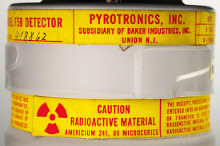 This radiation warning was hidden beneath the housing of a radioactive smoke alarm. The manufacturer put another case over it to hide the warning sticker from customers and retailers.
This radiation warning was hidden beneath the housing of a radioactive smoke alarm. The manufacturer put another case over it to hide the warning sticker from customers and retailers.
There are two main types of smoke detectors that are sold to the public: ionizing and photoelectric. They detect fires in differing ways. Both technologies are widely misunderstood, to the degree of there being rampant, ludicrous explanations that abound on the Internet from people who are simply ignorant of electronics. The ionizing smoke alarms utilize a radioactive material, americium-241, which is placed inside of what is referred to as an ionization chamber. This metallic chamber features a slight gap between its energized plates and the radioactive americium. This design produces what is essentially an internal radiation detector. Whenever the americium's radioactive emissions are warped (frequency changed) by smoke, the alarm sounds. Alternatively, the much safer photoelectric-based alarms utilize light instead of gamma radiation, wherein a beam of light is aimed to miss the sensor during normal operation. Whenever smoke is presented, the light is dispersed by it. This causes some of the scattered light to reliably strike the sensor, sounding the alarm.
A variety of watchdog groups have warned about the danger of having radioactive americium-241 inside homes, but they strangely retracted their warnings without explanations. Ralph Nader is one such example. He issued a warning in 1976, wherein he stated that the ionizing smoke detectors "unnecessarily subject Americans to the risks involved in radiation exposure".
There are no trustworthy sources for determining how severe the risk of americium exposure is, because all of the research has been done by the same nuclear industry that has sought innovative ways to dispose of its nuclear waste products, such as americium. The defenders of americium's use often state that the amount of radiation released is little different from that of the background radiation within a busy city. These proponents of child radiation exposure intentionally fail to mention the differences between electromagnetic radiation and nuclear radiation, for nuclear radiation (such as that which is produced by americium) is exceedingly more dangerous. Nevertheless, both types of radiation cause a variety of health issues, including cancers; especially the gamma radiation from nuclear materials. Despite the alleged "harmless" nature of the radioactive smoke detectors, customers are urged not to dispose of them as household garbage. Instead, American citizens are asked to return their old smoke detectors to manufacturers or to the Nuclear Regulatory Commission (NRC). Furthermore, according to F.E.M.A., the radioactive smoke detectors are an occupational hazard inside warehouses which store them. How is that for doublespeak? They are saying that we should put the radioactive product inside our houses, but not into the community dump, where their families might get environmentally exposed.
"When more than 100 detectors are to be stored, they should be located in areas not normally occupied by personnel... Where more than 200 detectors are stored in the same room, radiation monitoring devices should be used to check the radiation levels in the area."
-- F.E.M.A. Newsletter, December 2009
Within their public document, the U.S. Federal Emergency Management Administration omitted the part about producers needing to wear lead suits for protection. Funny how those omissions happen. The case of americium is quite similar to that of fluoride. It is another hazardous, industrial waste byproduct of the nuclear industry, for which the industry would have had to otherwise pay exorbitant fees to dispose of, if it had not found a way to make us feel that it is essential for our wellbeing. Americium is entirely an artificial element, which means that it never exists naturally. The nuclear industry found that it could actually sell it to us, for a profit, as something that we are supposed to believe is needed for our safety.
Technology Comparison
The two main types of smoke alarms have major differences in reliability. In "fast flame" fires, like those which are accelerated by petrochemicals, such as gasoline; the radioactive smoke detectors detected fires about 30 to 90 seconds faster than the photoelectric type. However, in slow-burning, smoldering fires, which comprise the vast majority of home and office fires, the photoelectric smoke alarms detected smoke 15-18 minutes sooner than the radioactive sensors. Moreover, the ionizing smoke detectors outright failed to function 20 percent of the time, according to studies.
Despite the shoddy results for the ionizing (radioactive) smoke detectors, which illustrate the prudence of exclusively using photoelectric smoke alarms, 95% of American homes with smoke detectors use the inferior, radioactive type. For this 95%, a portion of them will die from undetected fires, but a much larger portion of them will be said to have died from the (radiation-induced) cancers, even though it will be the radioactive cancer treatments that ultimately end most of their lives. Absolutely no-one from government, the nuclear industry, or the medical industry is held accountable.
Related Articles
Shielding Yourself From Radiation and Dangerous Radioactive Exposure From Cancer Patient Emissions
Quick Tip: Answering Questions about Radiation from Japan and Potassium Iodide
Granite Counter Tops Pose Health Risks
A New Method of Poisoning Us With Radiation: 'High Efficiency' Light Bulbs
The F.D.A.'s Push For Radioactive ("Irradiated") Foods
More Radiation Poisoning Coming Soon to a Hospital Near You
